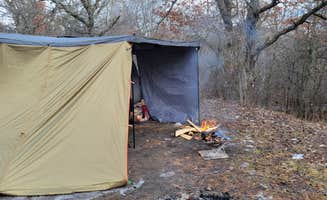South of Sand Dunes State Forest offers primitive dispersed camping on sandy terrain about 45 miles northwest of Prior Lake, Minnesota. The forest contains over 6,000 acres of oak savanna, pine plantations, and wetlands with elevations ranging from 960 to 1,020 feet. During summer months, temperatures typically range from 65-85°F with higher humidity levels making mosquito protection essential for comfortable rustic camping.
What to do
Hammock camping opportunities: Several dispersed sites feature ideal tree spacing for hammock setups. "I love that it's so close to home. I was able to walk in and find an incredible spot to camp and lay in my hammock," notes one South of Sand Dunes State Forest visitor.
Bird watching excursions: The forest hosts diverse bird species including sandhill cranes. "This is a nice quiet area... with lots of different bird sounds," reports a camper. Some visitors have noted territorial behavior from local birds, so maintain appropriate distance.
Off-road exploration: Multiple forest access points allow for different experiences. "I parked near the front and closer to numbers, always like to be safer. The road goes for a long ways," mentions one camper who appreciated the extensive network of forest roads.
What campers like
Midweek solitude: Weekday visits often result in quieter camping experiences. "After 12 p.m., not much of anything. I really recommend this for an easy stop if you're looking for a place to put up. It's peaceful and tons of spots to park," reports a repeat South of Sand Dunes State Forest visitor.
Accessibility from urban areas: The proximity to the Twin Cities makes this location practical for quick escapes. "For the proximity to the city and nearby highways, this was a good spot," notes one camper who appreciated the convenient location for rustic camping near Prior Lake.
Variety of parking spots: Different site configurations accommodate various camping styles. "There's lots of little spots off the main gravel road. Nothing allowed further into the forest. One pull through area that I found," explains a visitor who enjoyed the camping options.
What you should know
Vehicle restrictions: Some forest roads have access limitations. "A lot of the side roads are closed to motor vehicles due to some issues they had a couple years ago but are now taken care of like people dumping," explains one South of Sand Dunes State Forest camper.
Road traffic considerations: Despite the remote setting, forest roads can experience surprising traffic. "This road is pretty busy for a dirt forest road and people FLY down it. Almost got hit a few times walking. Even through a Wednesday night cars are flying down the road," cautions one visitor.
Law enforcement presence: Campers should understand regulations as enforcement varies. "I had a county sheriff person tell me it's not lawful to park a trailer and they kicked me out. I called the DNR and they said that wasn't right but I decided to leave anyway," reports one camper who experienced conflicting information.
Tips for camping with families
Site selection for shade: Look for sites with adequate tree cover during summer. "We did find one we thought we liked, but branches over hung, and rested on our camper (8ft high) and in fact most sites were shaded," notes a South of Sand Dunes State Forest visitor.
Wildlife education: Prepare children for wildlife encounters, including protective birds. "Sand storks are very protective. Stay away from them. They attack," warns one camper, suggesting an opportunity to teach children about respecting wildlife boundaries.
Bug management: Insect activity intensifies at certain times. "As to be expected, mozzies were present, but after 5mins of the door being opened and several flying in, we decided the area wasn't for us," shares one family, highlighting the importance of proper insect protection.
Tips from RVers
Vehicle size limitations: Most sites accommodate smaller rigs better than large motorhomes. "Great spot. Plenty of parking. Best for straight vehicles or very small trailers," advises a South of Sand Dunes State Forest camper with practical experience.
Truck camper accessibility: Smaller self-contained units navigate the area effectively. "I just did an overnight camp one night in a truck camper and it was very easy to navigate and it was cleaned quiet area to spend the night," reports one visitor who found the rustic camping near Prior Lake suitable for compact RVs.
Overhead clearance issues: Check for low-hanging branches before pulling into sites. "Most spots are like the pictures shown. There are a few spots that have great views or pull-through areas, and there are limited spots that are big-rig friendly," notes a camper describing the forest's site configurations.


